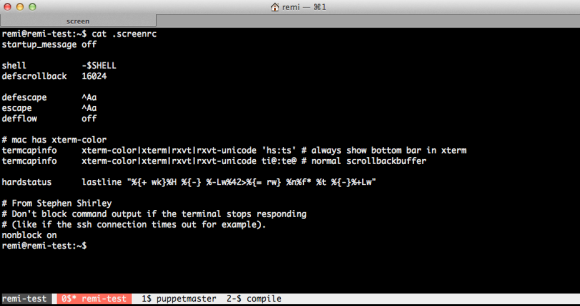I’m using SSH’s key-based authentication to login to my servers using a SSH key pair. Of course my private key is protected with a password of its own. This has the consequence that even with key-based authentication, you still need to type a password: your private key passphrase. And you need to type it on every single connect. Although this is far more secure that having no passphrase on your private key, typing it so many times is a bit over done.
In this blog I’ll show you how to setup a system where you enter the passphrase only once per day when you start a new terminal session. For me this works great, as I now only type my passphrase in the morning when I login to my workstation and am able to connect password-less the rest of the day. Whenever I leave my desk, my screen is locked so no one can access my key.
Setting up key-based authentication
The first step is to generate a key pair to use.
ssh-keygen -t rsa -b 2048
The output is something like below. Enter your passphrase twice, when prompted.
Generating public/private rsa key pair. Enter file in which to save the key (/home/remi/.ssh/id_rsa): Enter passphrase (empty for no passphrase): Enter same passphrase again: Your identification has been saved in /home/remi/.ssh/id_rsa. Your public key has been saved in /home/remi/.ssh/id_rsa.pub. The key fingerprint is: 41:22:af:8b:4b:aa:94:34:a4:fa:5a:eb:91:4c:5b:5e remi@wks The key's randomart image is: +--[ RSA 2048]----+ | . . . | | o o | | . . . | |o . . | |.o. o E S | |ooo* o | |.oO o | |.= + | |=o= | +-----------------+
To setup key-based authentication, copy your public key to the ‘.ssh/authorized_keys’ file on the server you want to connect to. You can do this by using ‘ssh-copy-id‘. You need to have access to the user account you want to connect to because you need to type its password to authenticate the copying.
ssh-copy-id -i ~/.ssh/id_rsa.pub user@server
You can now login to this server by typing only the passphrase of your private key, instead of typing the user account’s password.
Using ssh-agent to manage private keys
When you want to take this to the next level, you can use ‘ssh-agent‘ to manage your SSH keys. This program is started at login and remembers the keys you add each session. Through use of environment variables the agent can be located and automatically used for authentication when logging in to other machines using SSH.
The idea is that the agent is run in the user’s local PC, laptop, or terminal. Authentication data need not be stored on any other machine, and authentication passphrases never go over the network. However, the connection to the agent is forwarded over SSH remote logins, and the user can thus use the privileges given by the identities anywhere in the network in a secure way.
To add a key, run ‘ssh-add‘ and type the passphrase of your private key. This is needed only once per session. After you’ve added your key to ‘ssh-agent‘, you should be able to SSH to the local machine without entering a password. This is more secure than a key pair without a passphrase because whenever your key gets lost, one still needs to type your passphrase to get access.
Use case
At work, I SSH to a central server from which I can access all the other servers. My public key is distributed to all servers, my private key is on my workstation. Now, for secure password-less logins to work, I need to be able to access my local ssh-agent from this central server. When you SSH to your server as I describe above, you don’t have to type the passphrase. When you have a look at the environment variables, you’ll notice SSH_AUTH_SOCK is set. This variable holds the path to the socket connecting to your ‘ssh-agent‘ running on your local machine. Authentication is now done this way!
Getting this to work with GNU screen
There’s a little problem when using this technique with GNU screen. When you reconnect to a running screen session from another location, the environment variable inside screen is not updated and so you need to type the password for your private key on each connect again. I found this post that describes a solution, which I further enhanced to make it work correctly for me:
export SSH_AUTH_SOCK=$(find /tmp/ssh-* -user `whoami` -name agent\* -printf '%T@ %p\n' 2>/dev/null | sort -k 1nr | sed 's/^[^ ]* //' | head -n 1)
This one-liner looks for the most recent ssh-agent socket, owned by the current user and sets the SSH_AUTH_SOCK environment variable to this socket. You can now use this socket again to authenticate to your locally running ‘ssh-agent‘.
To make this a little easier, I added this scrip ‘update-ssh-agent-socket.sh‘ on my home directory on the central server (also available on github):
#!/bin/bash echo "Updating ssh-agent socket environment.." echo "Current value: $SSH_AUTH_SOCK" export SSH_AUTH_SOCK=$(find /tmp/ssh-* -user `whoami` -name agent\* -printf '%T@ %p\n' 2>/dev/null | sort -k 1nr | sed 's/^[^ ]* //' | head -n 1) if [ $? -gt 0 ]; then echo "ERROR!" exit $? fi echo "New value: $SSH_AUTH_SOCK" echo "All done!"
Run it like this to use the most recent ssh-agent socket (note the dot at the start):
. ~/update-ssh-agent-socket.sh
Usually I type ‘<CTR>+r update <enter>’ to quickly run this command from history. This is the quickest way I could think of to get everything working and make it easy to quickly login to our servers.







